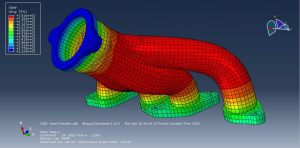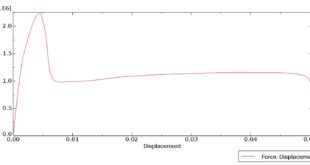Heat transfer in engine exhaust manifolds is governed by three effects: conduction through the metal, convection from the hot exhaust gases, and radiative exchange between different parts of the metal surface. This example illustrates the computation of the equilibrium thermal state of a manifold subject to these effects.The procedure consists of a single heat transfer step in which the thermal loading conditions are ramped up from zero. The boundary constraints on the manifold flanges are a simplification of those experienced under operating conditions: the temperatures at the cylinder head and the outlet are fixed. Convection due to heat transfer from the hot exhaust is applied at the internal surfaces of the manifold tubes. Radiation is modeled between the internal surfaces of the tubes using several methods: the cavity radiation method, with and without cavity parallel decomposition enabled, and using average-temperature radiation conditions.The manifold is cast from gray iron .The peak temperature in the field is higher when using the cavity radiation method. The effect of radiation heat transfer is to smooth out the temperature field in the equilibrium solution: high-temperature zones radiate more heat, which is absorbed by the cooler areas. In the cavity radiation method, this smoothing effect is limited and affected by the geometric view factors: the distance and orientation of the surface facets affects the degree to which radiation exchange can occur. This is not the case when using average-temperature radiation conditions. Each facet absorbs or emits radiative heat flux based on its temperature and the averaged cavity temperature only; the localizing effects of view factors are ignored. Therefore, the average method results reflect the greater smoothing effect of the radiation model used, resulting in lower peak values.You can see some figures of this simulation at below






You can provide CAE ,INP,and English video files of this simulation here. The cost of these files is Seventeen Euros. you can click on the bellow bottom to beginning process
You can purchase the tutorial through a PayPal account, a Visa, or a Master card, just before payment,send me an email to this address: karampourp@gmail.com
 Abaqus tutorials Abaqus tutorials
Abaqus tutorials Abaqus tutorials




